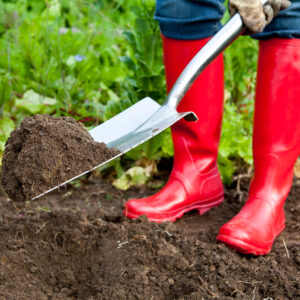Preparing the Veggie Plot for Spring Planting
If you’ve found yourself in the late winter garden dreaming of the homegrown veggie harvests ahead, this is quite literally the time to do the spadework. Vegetables grow best in well-prepared soil that provides good nourishment, retains moisture and is free of weeds and debris.
Getting started
The first step to preparing for spring planting is to remove weeds. Established weeds that are flowering or worse, already setting seed, must be pulled or dug out, the soil shaken gently from their roots and the weeds discarded. I throw weeds into the chook pen as a treat for the hens. If you don’t have chooks handy and the weeds are green, seed free and can’t regenerate, toss them into the compost heap.

Got chooks? Let them help you weed your veggie patch!
By the way, if you do have chooks and can contain them, it is possible to use them to weed and prepare the veggie patch for you. Either let them loose in the veggie patch during the day, or move them into a mobile pen (sometimes called a ‘chook tractor’) so they can scratch up the weeds for you without wandering throughout the garden. Move the pen around the beds that need to be weeded. Make sure chooks have access to water and shade as they work.
Weeds in seed, or with parts that can regrow such as stems, rhizomes or bulbs, should be soaked in a large container of water for around a week to stop them re-sprouting. Use the resulting water as a liquid feed and bury the residue or add it to the compost heap.
If the weeds are just beginning to sprout, work over the soil with a hoe, turning the weed seedlings back into the soil.

Once all weeds are gone, it's time to dig through your veggie patch.
Digging and fertilising
With the weeds dispatched, spread well-rotted manure or compost over the soil, then turn it in using a spade. If the soil is hard to dig, start off with a garden fork. Also add a complete pre-planting fertiliser for vegetables and work this in to the soil.
As you work, remove any stones and roots you uncover and break up any clods of earth. Work the soil digging down to about a spade’s depth, which is the area that the veggies you plant will grow in. The aim of digging over the soil is to make it suitable for veggies to establish and grow. Whether you plan to sow seeds directly or plant seedlings, make sure the soil is fluffy, easy to wet and that all additives have been well incorporated.
Finish by raking the soil level. This final raking also removes any extra stones or debris and makes it easier to set out planting rows. If the soil or weather conditions are too cold for planting, cover the worked soil with a layer of coarse organic mulch to deter future weeds. When it comes time to plant, just plant into the mulch or rake the mulch back to set out a planting row. Use a hoe to remove any weeds that sprout after you’ve prepared the soil.
As well as hoeing and digging, another option for preparing soil for vegetable growing is using a petrol-powered cultivator. These can be hired or purchased and make the job of soil preparation quick and easy especially if the area is large.

